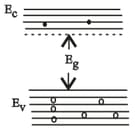Extrinsic Semiconductor
Extrinsic Semiconductor: Overview
This topic covers concepts, such as, Doping and Dopant, Doping, Energy Bands Diagram of N-type Semiconductor & Energy Bands Diagram of P-type Semiconductor etc.
Important Questions on Extrinsic Semiconductor
Which of the following energy band diagram shows the N-type semiconductor
No crystal is found to be prefect at room temperature. The defects present in the crystals can be stoichiometric or non-stoichiometric. Due to nonstoichiometric defects, the formula of the ionic compound is different from the ideal formula. For example, the ideal formula of ferrous oxide should be but actually in one sample, it was found to be . This is because the crystal may have some ferric ions in place of ferrous ions. These defects change the properties of the crystals. In some cases, defects are introduced to have crystals of desired properties as required in the field of electronics. Doping of elements of Group 14 with those of Group 13 or 15 is most common. In ionic compounds, usually impurities are introduced in which the cation has higher valency than the cation of the parent crystal, e.g., into .
Which one of the following doping will produce p-type semiconductor ?
The hole density and electron density in -type semiconductors are related as
Range of energy required by electron of valance band to move into hole is . The accepter energy level lies
Which of the following energy band diagram shows the N-type semiconductor
A common p-type doped for silicon is boron or _____.
There are two types of dopants,n-type dopants and p-type dopants.
The energy gap between conduction band and valence band in semiconductor is
In the energy band diagram given in figure open circles and filled circles denote hole and electrons respectively. The material is

A semiconductor has equal electron and holes concentration of . On doping with certain impurity, electron concentration becomes . Then the semiconductor is
Electric current in extrinsic semiconductor in respect of mobility is expressed as
Electric current in extrinsic semiconductor is
The electric current in an extrinsic semiconductor is the sum of currents due to electrons and holes
In an n-type semiconductor, majority charge carriers are electrons.
If and represent the number density of electrons and holes in extrinsic semiconductor respectively then for semiconductors.
When Pentavalent atoms are added to pure semiconductor then which type of extrinsic semiconductor is found
Silicon doped with boron or gallium is a perfect example of p-type semiconductor.
In a p-type semiconductor, there is an _____ in the density of unfilled states.
_____ is the process of adding impurities to intrinsic semiconductors to alter their properties.
What is the meaning of dopant?
